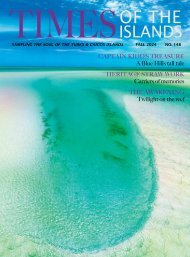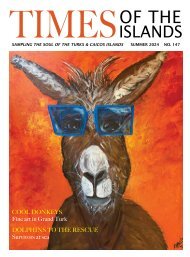Times of the Islands Spring 2021
Presents the "soul of the Turks & Caicos Islands" with in-depth features about local people, culture, history, environment, real estate, businesses, resorts, restaurants and activities.
Presents the "soul of the Turks & Caicos Islands" with in-depth features about local people, culture, history, environment, real estate, businesses, resorts, restaurants and activities.
Create successful ePaper yourself
Turn your PDF publications into a flip-book with our unique Google optimized e-Paper software.
In <strong>the</strong> 1960s before development started on<br />
Providenciales, <strong>the</strong> TCI Government had a work program<br />
run by <strong>the</strong> district constables. This made it possible for<br />
some <strong>of</strong> <strong>the</strong> residents to earn money. At that time, most<br />
families made a living farming <strong>the</strong> land and fishing <strong>the</strong><br />
sea, but cash was needed to buy a few staples—flour, oil,<br />
sugar, for instance.<br />
In Blue Hills <strong>the</strong> main work was to build a road in front<br />
<strong>of</strong> <strong>the</strong> settlement tracing <strong>the</strong> beach. Rocks were carried<br />
from <strong>the</strong> bush and placed in <strong>the</strong> sand. O<strong>the</strong>r rocks were<br />
broken up into smaller pieces using a hammer, <strong>the</strong>n<br />
placed in <strong>the</strong> voids between <strong>the</strong> larger rocks. After that,<br />
sand was hauled up in buckets from <strong>the</strong> beach and sprinkled<br />
over <strong>the</strong> rock base to make a smooth surface.<br />
Ano<strong>the</strong>r work project had been to build a 700-foot<br />
long airstrip located in <strong>the</strong> valley where Kew Town is<br />
today. The bushes were cleared and <strong>the</strong> largest rocks<br />
removed.<br />
In 1966, Fritz Ludington formed Provident Limited<br />
and made a lease purchase agreement with <strong>the</strong> TCI<br />
Government to develop 4,000 acres on <strong>the</strong> eastern part<br />
<strong>of</strong> Providenciales. In October 1966 Fritz, toge<strong>the</strong>r with<br />
his friend Tommy Coleman and me arrived by boat on<br />
Providenciales to start <strong>the</strong> development. The boat was a<br />
65 foot workboat named <strong>the</strong> Seven Dwarves. I was hired<br />
as a surveyor/engineer but <strong>the</strong> true job description was<br />
more like “to do anything that was needed.”<br />
Fritz understood that to have an efficient operation,<br />
we needed to be able to come and go in a faster way<br />
than by boat. We took a look at <strong>the</strong> 700 feet that had<br />
been cleared and Fritz decided that his wife’s plane could<br />
probably be used to land <strong>the</strong>re, even if <strong>the</strong> surface was<br />
pretty rough. Chris Ludington’s plane was a Cessna 180<br />
with US registration number 74C, “74 Charlie” in pilot<br />
lingo. Fritz needed to get back to <strong>the</strong> mainland and a few<br />
days later 74 Charlie showed up for <strong>the</strong> historical landing.<br />
(I was told that one or two airplanes had landed on <strong>the</strong><br />
strip prior to our arrival on Providenciales. I could never<br />
get that confirmed so I don’t know if we were watching a<br />
“first” landing or not.)<br />
For <strong>the</strong> next six months we used <strong>the</strong> air strip quite<br />
a lot. I think Chris wound up with <strong>the</strong> short end <strong>of</strong> <strong>the</strong><br />
stick because Provident more and more took over <strong>the</strong> use<br />
<strong>of</strong> her plane. During this time Fritz hired Embry Rucker<br />
as a pilot (among o<strong>the</strong>r things). Embry recently published<br />
a book, Coming in for a Landing, where he tells<br />
about flying in <strong>the</strong> <strong>Islands</strong> in <strong>the</strong> early days. The book is<br />
available on Amazon and is also for sale at <strong>the</strong> Turks &<br />
Caicos National Museum. (See https://www.timespub.<br />
tc/2019/03/up-up-and-away/).<br />
Fritz Ludington himself was an experienced pilot,<br />
as were many o<strong>the</strong>rs in <strong>the</strong> Provident group. Aviation<br />
was very important in <strong>the</strong> early development <strong>of</strong><br />
Providenciales.<br />
When <strong>the</strong> heavy equipment arrived in April 1967,<br />
<strong>the</strong> first priority was to improve on <strong>the</strong> existing airstrip.<br />
Provident had chartered Margaret <strong>of</strong> Exuma, a self propelled<br />
barge fully loaded with heavy equipment. The<br />
Bahamian captain entered through Sellar’s Cut, <strong>the</strong>n zigzagged<br />
between <strong>the</strong> coral heads up to <strong>the</strong> beach where<br />
This 1966 image shows “74 Charlie” on take-<strong>of</strong>f from <strong>the</strong> original 700-foot airstrip.<br />
18 www.timespub.tc

















